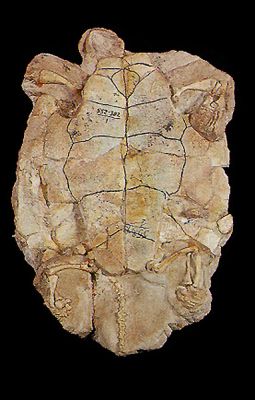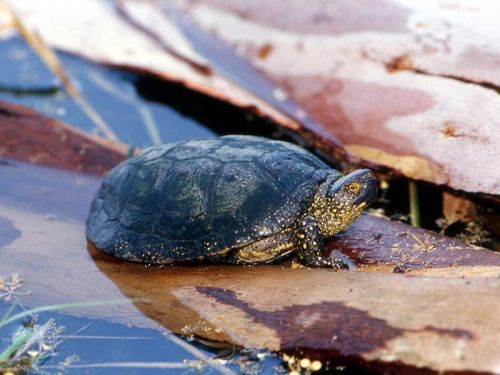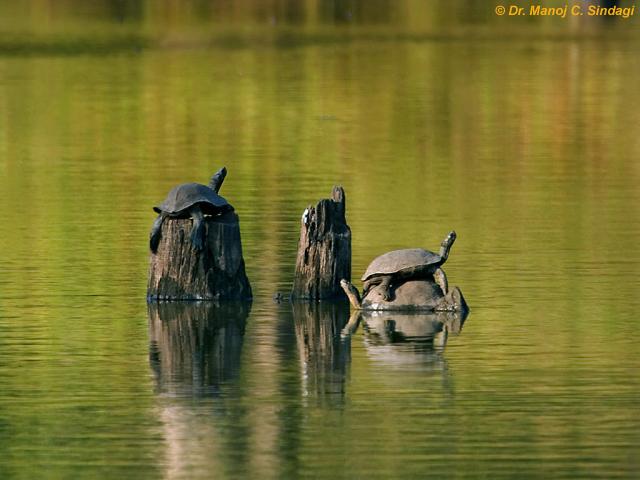
| Chelonii | ||
| The Vertebrates | Testudinoidea |
| Vertebrates Home | Vertebrate | Vertebrate |
|
Abbreviated Dendrogram
Anapsida ?
│
└─○Chelonii
├─Odontochelys
└─┬─Proganochelys
└─┬─Proterochersis
└─┬─Meiolanoidea
└─┬─Pleurodira
├─Paracryptodira
└─┬─Protostegidae
└─┬─Angolachelonia
╘═╤═Xinjiangchelyidae
└─○Centrocryptodira
╞═Sinemydidae
├─Trionychoidea
└─┬─┬─Chelonioidea
│ └─┬─Chelydridae
│ └─Kinosternoidea
└─○Testudinoidea
╞═Lindholmemydidae incl. Mongolemys
└─┬─Emydidae
└─○Testudinoidae
├─Echmatemys
└─┬─Geoemydidae
└─Testudinidae
|
Contents
Overview |
Taxa on This Page
The Testudinoidea are the largest living group of testudines, and include a variety of both semi-aquatic and fully terrestrial types. Evolving from semi-aquatic ancestors during the late Cretaceous, the true tortoises are among the few groups of testudines that adopted a fully terrestrial lifestyle. By the early Cenozoic they were common in North America, Europe, Asia, and Africa. For some reason, they didn't make it to South America or Australia, where Pleurodires and Meiolaniids predominated instead. Like the Meiolaniids, they evolved a number of distinct island dwelling forms.
Testudinoidea = Pantestudinoidea of Joyce et al 2004
Range: Cretaceous to Recent
Phylogeny: Centrocryptodira or Durocryptodira : Sinemydidae + ((Macrobaenidae + Chelonioidea-Chelydridae-Kinosternoidea clade) + * : Mongolemys + (Emydidae + Testudinoidae))
Characters: "Skull without parieto-squamosal arch, and squamosal separated from postorbitofrontal,with a fortune it palatinum between the palatine and maxilla. Articular fenestrae in the sixth and seventh cervical vertebrae not plane, and two of the cervicals biconvex. Nuchal without well-developed costiform processes ; series of inframarginals incomplete." - Zittel, Eastman, et al (1932) p. 202
Comments: The superfamily Testudinoidea is the most speciose of the testudines, including the true tortoises and most fresh-water and semi-aquatic turtles
Included here are three major crown clades, Testudinidae, Emydidae, and Bataguridae, along with a number of fossil taxa from the Cretaceous of Asia, such as Lindholmemys and Mongolemys (Joyce et al 2004 p.1005), which are placed in the paraphyletic family Lindholmemydidae. Two other poorly known Asian Cretaceous families, the Haichemydidae and the Sinochelyidae, may or may not belong here.
Molecular sequencing unambiguously nests the Asian genus big-headed turtle Platysternon megacephalum within crown Testudinoidea. Morphological cladistic analysis, equally unambiguously places it in or near the Chelydridae. There being no resolution for this disagreement between equally robust but conflicting phylogenetic hypotheses, we have for now retained Platysternon among the chelydrids
Although molecular dating indicates a Latest Cretaceous age (Campanian-Maastrichtian) (ref) or 95.0 Mya Lourenço et al 2012 for the radiation of modern testudinoids, the latter date being coeval with the larger Durocryptodire radiation event, this dating may not be reliable (consider the overestimation ofd age with placental mammals), as no fossils are known earlier than the Late Palaeocene, and the group only became well established by the early Eocene, where it is represented by the geoemydids Paleoemys and Merovemys and the testudinids Hadrianus and Achilemys. Conversely, the divergence of higher testudinoid clades may be found within the paraphyletic Lindholmemydidae, in which case inframarginal scutes, a character that distingusihes Lindholmemydids from modern testudinoids, were reduced or lost independently in extant families (Lourenço et al 2012 p.502) MAK130307
 |
| Commemorative stamp featuring Mongolemys elegans |
Mongolemys elegans Khosatzky and Mlynarski, 1971
Horizon: Nemegt Formation, Latest Cretaceous (Early Maastrichtian) of Mongolia
Comments: Mongolemys elegans It is the best known of the Lindholmemydidae, a diverse and almost certainly paraphyletic assemblage of otherwise poorly known Mid Cretaceous to Paleocene stem-testudinoids. Known from abundant specimens at all stages of growth from Latest Cretaceous pond deposits from Mongolia, bone histology shows similar patterns of thickness and bone tissue type as freshwater turtles. (Cadena et al 2013). It was originally initially assigned to Dermatemydidae by Khosatzky and Mlynarski (1971) based on similarities of this fossil to Central American river turtle Dermatemys mawii, but these are more plesiomorphic features and the result of convergences due to shared lifestyle. Morphological computational analysis unambiguosly places M. elegans as a stem testudinoid (Cadena et al 2013).
The Lindholmemydidae represent a paraphyletic assemblage, either of stem forms or early representatives of extant groups (Lourenço et al 2012) or both. They are defined by the presence of inframarginal scutes, a feature lost in modern Testudinoidea Genera such as Lindholmemys and Mongolemys have been placed within 'Testudinoidea' primarily because of the development of an ossified bridge connecting the plastron with the carapace (Joyce et al 2004 p.1005).
 |
| Mongolemys elegans skeleton and carapace, from The Russian Dinosaur Exposition, original url. Also at Mathematical com |
Lindholmemydids first appears in the mid Cretaceous. Mongolemys occidentalis from the Late Albian or early Cenomanian of Uzbekistan was reassigned to the separate genus Khodzhakulemys, and represents the oldest well-known testudinoid occurence, and so can be used for constraining the age of the divergence of testudinoids and chelonioids. Lourenço et al 2012. Tsaotanemys is tentatively from the ?Albian of China so it can be considered a similar age. Purported stem testudinoid material has been been reported from the Early Cretaceous Kuwajima formation (Barremian-Aptian) of Japan (Hirayama, 2000), but this was not described in detail, and as no diagnostic characters were listed it is not possible to assess this claim cladistically.
Other Lindholmemydids include Paragravemys from the Cenomanian-early Turonian of Mongolia, Lindholmemys from the Turonian to early Campanian of Middle Asia and Kazakhstan, Hongilemys from the Turonian-Campanian of Mongolia, Gravemys from the Maastrichtian of Mongolia (a contemporary of Mongolemys), and Amuremys from the Maastrichtian of the Amur River (Russia-China border), and Hokouchelys and Elkemys from the Paleocene of China. (Cadena et al 2013).
Elkemys australis is similar to Gravemys barsboldi. Those two species and Hokouchelys chenshuensis from the Paleocene of China differ from other lindholmemydids and testudinoids in their unique inframarginal pattern (four or five pairs of wide inframarginal scutes which strongly extend on to peripherals), and may form a clade or grade of basal testudinoids. Other characters (large anal notch and relatively narrow vertebrals 2 and 3) are shared by some geoemydids and testudinids and may indicate closer relations of the three mentioned genera to these groups. (Danilov et al 2012 p.21)
New material also reveals a previously unrecognized cranial similarity between M. elegans and geoemydid testudinoids: contact between the quadrate and the parietal, which are well exposed dorsally at the roof of the otic chamber and encapsulate the foramen stapedius temporalis. In other testudinoids, the prootic bone generally prevents contact between the parietal and quadrate at the dorsal roof of the otic chamber, which implies this feature may be convergently acquired. (Cadena et al 2013 p.21) MAK130303
 |
| The European pond turtle Emys orbicularis, one of the few emydids found outside the Americas. Photo by Nicola Maraspini. (via CKT) |
Emydidae Rafinesque, 1815 : terrapins, and box, pond and river turtles,
Range: Paleocene to Recent
Phylogeny: Testudinoidea : Testudinoidae + *
Characters: (from Gaffney & Meylan 1988): Batagurine process absent, no pterygoid-basioccipital contact; angular usually reaching Meckel's cartilage; double articulation of fifth and sixth cervical; chromosome number 2n = 50. (via CKT)
Comments: The Emydidae are a diverse group, which together with Eurasian terrapins make up the largest group of extant chelonians. They include mostly aquatic tortoises, although some are semi-aquatic or terrestrial. All are omnivores. The feet usually have webbing between toes and claws. All of the 12 genera and 46 extant species are found today in the western hemisphere, with the exception of Emys orbicularis in Europe and western Asia. The family includes the red-eared slider Trachemys scripta which has, thanks to the pet trade, reversed the grim fate facing many extant testudine species by becoming an invasive species in many parts of the world. (CKT, Study notes)
Both morpholological-cladistic (Gaffney & Meylan 1988) and molecular studies (Iverson et al 2007, Thomson & Shaffer 2010, Guillon et al 2012) divide this family into two main clades, the Emydinae (with the genera Clemmys, Emys, Terrapene, and according to molecular sequencing Glyptemys) and Deirochelyinae (with the genra Chrysemys, Deirochelys, Graptemys, Malaclemmys, Pseudemys, and Trachemys).
A number of fossil forms have been associated with the group. They were most varied during the Paleocene in Asia, and it is likely this continent their probable site of origin. Late Paleocene emydids from Asia include Anhuichelys, Hokouchelys and Pseudochrysemys. In North America at this time they are known from a single unnamed large headed genus (known informally as "Emydid C") that appears in the Middle Paleocene and is the most common turtle of this region in the Late Paleocene. This jaws of this species have simple triturating surfaces, which suggest a mixed diet Jehle, 2006. To date, none of these early fossil forms have been integrated into a cladistic analysis (Joyce et al 2004 p.1006). Perhaps a more unambiguous fisrt record of oldest crown emydid is "Chrysemys" antiqua from the Latest Eocene Chadronian of South Dakota (Hutchison, 1996, via Lourenço et al 2012 p.505
There were also a number of other forms of uncertain phylogenetic position, such as for example Broilia, from the Oligocene of France, which was assigned to Emydidae by Carroll (1988). This large genus, with a 75cm long shell, had cartillaginous attachments connecting the plastron to the carapace, providing a very flexible link on both sides. These animals had somewhat domed shells which implies a semi or fully terrestrial lifestyle. ref
 |
| Indian pond turtles Melanochelys trijuga (subfamily Geoemydinae), photographed by Manoj Sindagi. |
Synonym: Testuguria
Range: Fr the Late Palaeocene
Phylogeny: Testudinoidea : Emydidae + * : Echmatemys + (Batagurinae + (Geoemydinae + Testudinidae))
Characters: (from Gaffney & Meylan 1988): (Including Echmatemys) Axillary and inguinal musk duct foramina enclosed within peripheral plates or between peripherals and plastral buttresses. (Excluding Echmatemys) Sixth marginal scute often reaching third pleural scute; postorbital-squamosal contact absent. (CKT)
Comments: Testudinoidae, not to be confused with Testudinoidea, is a proposed clade uniting the land tortoises of the Testudinidae with the Asian pond turtles of the 'Bataguridae'. Although it is agreed that the Testudinidae and Bataguridae/Geoemydidae share a close phylogenetic relationship he monophyly of this clade is unsettled, as proposed synapomorphies are also found in other testudinates, and are not universal within testudinoidaens. (Gaffney & Meylan 1988). (CKT). They may be sister taxa (Gaffney 1979) or the batagurids may be paraphyletic with regard to testudinids (Hirayama 1984; Gaffney & Meylan 1988). Molecular phylogeny however unambiguously distinguishes the Testudinoidae from the Emydidae + Platysternidae (ref, ref, ref Lourenço et al 2012).
Range: Eocene of North America and West Asia
Phylogeny: Testudinoidae : (Batagurinae + (Geoemydinae + Testudinidae)) + *
Comments: A stem Batagurid known from several species, its exact phylogenetic position is unclear (Joyce et al 2004 p.1006). It is tentatively placed here as a stem Testudinoid. A medium-sized testudine with a shell 30 to 45 cm long, depending on the species (Mlynarski 1976, p.88), MAK130306
 |
| Female Chinese striped-neck turtle Ocadia sinensis, photographed by Tim McCormack. |
Geoemydidae Theobald, 1868 : Asian river turtles, Asian leaf turtles, Asian box turtles and roofed turtles
Synonym: Batagurina Gray 1869, Bataguridae Gray 1870; Panbataguridae Joyce et al 2004
Range: Early Eocene to Recent
Phylogeny: Testudinoidae : + *
Characters: (from Gaffney & Meylan 1988): Fissura ethmoidalis oval and broad; frontals sometimes excluded from orbital rim by prefrontal-postorbital contact; foramen palatinum posterius small, excluded from pterygoid. - CKT
Comments: The Geoemydidae, or Bataguridae as they are also called (the two names being used sysnonymously in different scientific papers, although Geoemydidae has priority) include the Asian river, leaf, roofed or Asian box turtles. There are 24 extant genera and 62 extant species, making up a significant proportion of the species of extant turtles. The demands of the food and pet trade has meant that many species are now endangered, some critically.
According to cladistic studies (Gaffney & Meylan 1988), the family Geoemydidae or Bataguridae is paraphyletic assemblage that gave rise to, and hence according to cladistic formalism includes, the Testudinidae. See dendrogram by CKT here and here. But according to molecular studies this is an unambiguously monophyletic group. Several subfamilies have been posited, such as Batagurinae and Geoemydinae, but they seem to have neither cladistic nor molecular support.
Determining the molecular phylogeny of the geoemydid turtles is difficult due to their propensity to hybridize, even between unrelated genera such as Sacalia and Cuora. Regardless of whether or not this is the case in wild populations, human husbandry and transport in the food and pet trades, and hence opportunity for genetic contamination through escape and hybridization, complicate efforts to understand the evolution of this group, and identify valid species (Iverson et al 2007 p.94)
A number of primitive fossil forms have been interpreted as stem taxa but the phylogenetic relationships of most of these relative to the extant species remain unclear. (Joyce et al 2004 p.1006). Paleoemys and Merovemys from the Early Ypresian of France mark the oldest known occurrences of crown Geoemydidae (Lourenço et al 2012 p.505)
Page last modified MAK130307.
All material by ATW is public domain and may be freely used in any way (also any material jointly written by ATW and MAK). All material by MAK is licensed Creative Commons Attribution License Version 3.0, and may be freely used provided acknowedgement is given. All Wikipedia material is either Gnu Open Source or Creative Commons (see original Wikipedia page for details). Other graphics are copyright their respective owners